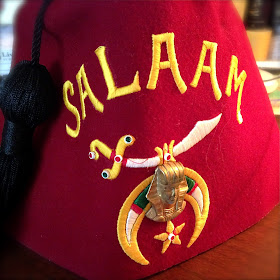It’s rare I mention the Shriners here on The Magpie, but Bro. Bill (of Knights of the North, etc. fame) shared something on Facebook today that cracks me up.
An eBay seller offers a Shrine fez this week, claiming it was owned and worn by U.S. Army legend Audie Murphy, who was the most decorated American serviceman in the Second World War, and a Freemason and Shriner.
The starting bid, which has not materialized yet, is to be $998. I encourage any potential buyer to have a very close look before bidding.
The lot is titled “Audie Murphy Owned Hella Shriner Freemasonry Hat & Case Dallas Texas 1957.” The photo:
The lot description:
This is a hat that was owned and worn by Audie Murphy.
Audie became interested in Freemasonry in 1955.
He became a Shriner (Hella Temple, Dallas) on November 15, 1957.
Audie often participated in Shrine parades.
Please see all seven of my ebay pictures.
One of them was shown in The American Soldier book by Harold B. Simpson
on page 336. This photo shows Audie wearing the hat.
Under the photo it says: Audie, shortly after becoming a Shriner, in a Dallas
Shrine parade on November 15th 1957.
The hat is in a wonderful case that I think is leather. Audie’s initials are
on the top and one of my pictures shows his name on the inside of the case.
Both the hat and case are in Excellent Condition!
First, although the photo of Murphy wearing a Shrine fez is blurry, you can see clearly that he is not wearing the fez that is listed for sale here. The fez in the black and white photo from 1957 has the scimitar above the crescent. Just like my grandfather’s fez of 1960s vintage:
But the fez on eBay has the scimitar-through-the-crescent design. Second, the old fezzes were embroidered pretty simply. These “bejeweled” fezzes, with the fake rhinestones and all that, came later. (Murphy died in 1971.)
I communicated my concerns to the seller, and promptly received this reply:
Hello,
Thanks for taking the time to write and give me your opinion.
Because of where I purchased it I am 100% confident that
this hat belonged to Audie Murphy. He became a Shriner in 1957...not in the 1960s.
My ebay picture is not real clear because the photo in the
book is not good but if you have the book you might take a look at it closely
and you will see that the men in the photo with Audie are all wearing hats and
the designs on them are very different. My hatbox also has the design different
from the hat.
I paid almost 3 times the amount that I am asking for them
and from where they came I will say again that I am certain they were owned by
Audie.
Thanks.
So buyer beware! This is why I buy only from newly signed up sellers in Russia and China.
I am no expert on the collectibility of Shriner fezzes, but paying three thousand bucks for one fez—and let’s say it was in fact owned and worn by Audie Murphy—is nuts. (And if you did something that stupid, wouldn’t you at least know to call it a fez, and not a hat?) The $998 isn’t much smarter. I have watched enough History channel to understand how famous people’s antiques, autographs, and personal effects are valued, and this offering is a bit much. No mention of a certificate of authenticity either. I do recall several years ago some of Sir Winston Churchill’s Masonic items went under the gavel and fetched about $500.
That’s Winston Churchill of saving-the-world-fame.
Audie Murphy is remembered as a peerless war hero and even a movie star, so I reckon personal effects of his that are connected to his wartime service and screen career would be the valuable mementos. His Shrine membership? A note in a book of Masonic trivia.
Caveat emptor! (That means look out for the quicksand.)






























